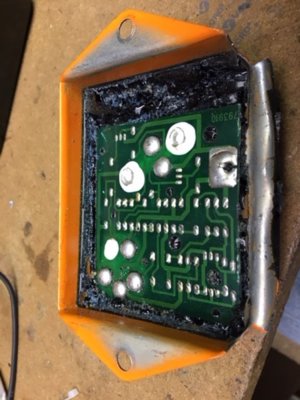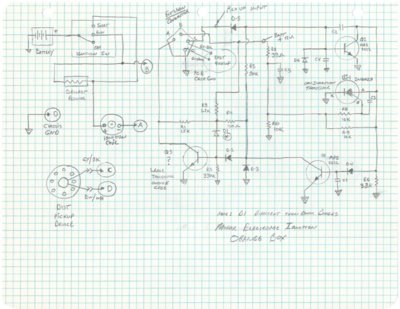For those of you electronically inclined that would like to know whats really in the ECU, or orange box of the electronic ignition system, here is a schematic of the "Orange Box". I think that the KEY to the way this circuit works is the UJ-1 device which is a " Programmable Uni-junction Transistor". Reading up on this device, it is basically a switching device, but a programmable and accurate one, in that when triggered, it will always provide a repeatable on/off cycle duration. This devices switching function is not affected by voltage variations in the cars electrical / charging system.
The pickup device in the distributor is triggered by the "reluctor", a star wheel that creating pulses with rotation in the pickup coil. When a point of the star aligns with the pickup device, a trigger pulse is sent to the orange box on pin on "C". The orange box circuitry amplifies this pulse, shapes it to be of consistent duration ( UJ-1) , and turns on, or causes to "conduct" the large silver Q-3 power transistor which is visible on the heat sink on the outside of the orange box case. This power transistor is basically completing, or switching the ignition coils minus (-) terminal to the cars chassis ( Ground) to induce, or switch, and complete the path to ground, of the ignition coils primary winding. This pulsing DC applied to the coil steps up battery volts to several thousand volts to make the spark that the distributor sends to the plugs. Basically the large power transistors emitter (E) to collector (C) junction provides a switched path to ground, much as the points type distributor did. And, yes, you should carry a spare ....


The pickup device in the distributor is triggered by the "reluctor", a star wheel that creating pulses with rotation in the pickup coil. When a point of the star aligns with the pickup device, a trigger pulse is sent to the orange box on pin on "C". The orange box circuitry amplifies this pulse, shapes it to be of consistent duration ( UJ-1) , and turns on, or causes to "conduct" the large silver Q-3 power transistor which is visible on the heat sink on the outside of the orange box case. This power transistor is basically completing, or switching the ignition coils minus (-) terminal to the cars chassis ( Ground) to induce, or switch, and complete the path to ground, of the ignition coils primary winding. This pulsing DC applied to the coil steps up battery volts to several thousand volts to make the spark that the distributor sends to the plugs. Basically the large power transistors emitter (E) to collector (C) junction provides a switched path to ground, much as the points type distributor did. And, yes, you should carry a spare ....





















